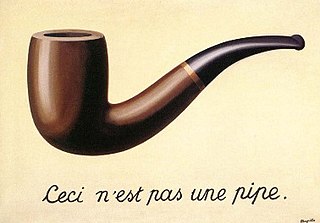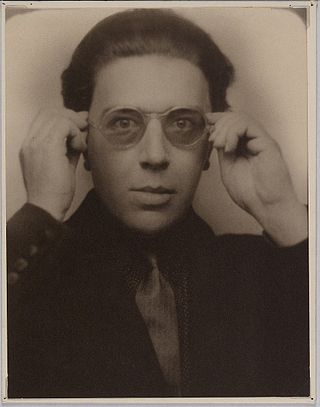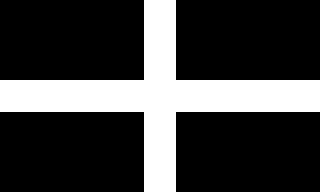
Breton is a Southwestern Brittonic language of the Celtic language group spoken in Brittany, part of modern-day France. It is the only Celtic language still widely in use on the European mainland, albeit as a member of the insular branch instead of the continental grouping.

Surrealism is an art and cultural movement that developed in Europe in the aftermath of World War I in which artists aimed to allow the unconscious mind to express itself, often resulting in the depiction of illogical or dreamlike scenes and ideas. Its intention was, according to leader André Breton, to "resolve the previously contradictory conditions of dream and reality into an absolute reality, a super-reality", or surreality. It produced works of painting, writing, theatre, filmmaking, photography, and other media as well.

Brittany is a peninsula, historical country and cultural area in the north-west of modern France, covering the western part of what was known as Armorica in Roman Gaul. It became an independent kingdom and then a duchy before being united with the Kingdom of France in 1532 as a province governed as a separate nation under the crown. Brittany is the traditional homeland of the Breton people and is one of the six Celtic nations, retaining a distinct cultural identity that reflects its history.

André Robert Breton was a French writer and poet, the co-founder, leader, and principal theorist of surrealism. His writings include the first Surrealist Manifesto of 1924, in which he defined surrealism as "pure psychic automatism".

Marie de France was a poet, likely born in France, who lived in England during the late 12th century. She lived and wrote at an unknown court, but she and her work were almost certainly known at the royal court of King Henry II of England. Virtually nothing is known of her life; both her given name and its geographical specification come from manuscripts containing her works. However, one written description of her work and popularity from her own era still exists. She is considered by scholars to be the first woman known to write francophone verse.

The Duchy of Brittany was a medieval feudal state that existed between approximately 939 and 1547. Its territory covered the northwestern peninsula of Europe, bordered by the Atlantic Ocean to the west, and the English Channel to the north. It was also less definitively bordered by the river Loire to the south, and Normandy, and other French provinces, to the east. The Duchy was established after the expulsion of Viking armies from the region around 939. The Duchy, in the 10th and 11th centuries, was politically unstable, with the dukes holding only limited power outside their own personal lands. The Duchy had mixed relationships with the neighbouring Duchy of Normandy, sometimes allying itself with Normandy, and at other times, such as the Breton–Norman War, entering into open conflict.

Saint Piran's Flag is the flag of Cornwall. The earliest known description of the flag, referred to as the Standard of Cornwall, was written in 1838. It is used by all Cornish people as a symbol of their identity.

Sir Orfeo is an anonymous Middle English Breton lai dating from the late 13th or early 14th century. It retells the story of Orpheus as a king who rescues his wife from the fairy king. The folk song Orfeo is based on this poem.
The lais of Marie de France are a series of twelve short narrative Breton lais by the poet Marie de France. They are written in Anglo-Norman and were probably composed in the late 12th century, most likely between 1155-1170. The short, narrative poems generally focus on glorifying the concept of courtly love by the adventures of their main characters. Marie's lais are thought to form the basis for what would eventually become the genre known as the Breton lais. Despite her stature in Anglo-Norman literature and medieval French literature generally, little is known of Marie herself, but it is thought that she was born in France and wrote in England.

A Breton lai, also known as a narrative lay or simply a lay, is a form of medieval French and English romance literature. Lais are short, rhymed tales of love and chivalry, often involving supernatural and fairy-world Celtic motifs. The word "lay" or "lai" is thought to be derived from the Old High German and/or Old Middle German leich, which means play, melody, or song, or as suggested by Jack Zipes in The Oxford Companion to Fairy Tales, the Irish word laid (song).
The Surrealist Manifesto refers to several publications by Yvan Goll and André Breton, leaders of rival surrealist groups. Goll and Breton both published manifestos in October 1924 titled Manifeste du surréalisme. Breton wrote a second manifesto in 1929, which was published the following year, and in 1942, a reflection or a commentary on the potential for a third manifesto, exploring how the Surrealist movement might adapt to changing times.

Breton literature may refer to literature in the Breton language (Brezhoneg) or the broader literary tradition of Brittany in the three other main languages of the area, namely, Latin, Gallo and French – all of which have had strong mutual linguistic and cultural influences.

The Bretons are an ethnic group native to Brittany, north-western France. Originally, the demonym designated groups of Brittonic speakers who emigrated from southwestern Great Britain, particularly Cornwall and Devon, mostly during the Anglo-Saxon settlement of Britain. They migrated in waves from the 3rd to 9th century to Armorica. The region was subsequently named after them, as were the inhabitants of Armorica as a whole.

Bertrand d'Argentré was a Breton jurist and historian.

Catholicon is a 15th-century dictionary written in Breton, French, and Latin. It is the first Breton dictionary and also the first French dictionary. It contains six thousand entries and was compiled in 1464 by the Breton priest Jehan Lagadeuc. It was printed in 1499 in Tréguier. A dictionary manuscript is preserved in the national library in Paris, identified as Latin 7656.

Pierre Le Baud or Lebaud was a French clergyman and historian known for his writings on the history of Brittany.
Elisa Breton, was a French artist and writer, and the third wife of the French writer and surrealist André Breton.

Jeanne de Clisson (1300–1359), also known as Jeanne de Belleville and the Lioness of Brittany, was a French/Breton noblewoman who became a privateer to avenge her husband after he was executed for treason by King Philip VI of France. She crossed the English Channel targeting French ships and often slaughtering their crew. It was her practice to leave at least one sailor alive to carry her message of vengeance.
Albert Le Grand was a Breton hagiographer and a Dominican brother.
The Leyden manuscript is the name usually given in Breton studies to a four-page leaflet ("bifolio") kept in Leiden University Libraries in the Netherlands. It is a fragment of a Latin medical treatise dating from the 9th or late 8th century in which two Irish words appear and about thirty Old Breton words.














